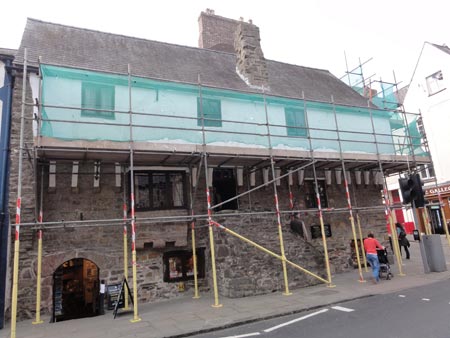Continued from Part Four
We’ve reached the final chapter of our action-crammed nine-day adventure in Wales. This last segment begins with a visit to a part of the country I’d always wanted to see, the island of Anglesey, which forms the northwest corner of Wales. The place has been in the news recently because Prince William and Kate – pardon me, the Duke and Duchess of Cambridge – are living there during his military service, and we did see and hear several military aircraft roaring over the area. But mostly, Anglesey feels like a very quiet corner, or at least it does in early spring, and quiet certainly characterized Beaumaris, the castle town we visited.
This old house is marked as having been built about 1400. I have to admit this is not the kind of provenance (or architecture) we come across in New York.

Beaumaris Castle has a decisive moat.

As usual in these waterside locales, seabirds sailed overhead and perched on the towers, making a lot more noise than the sheep grazing in the distance or the occasional tourist. On the other hand, keeping the grass neatly cut in the castle courtyard is a job that must keep someone busy.


The “Gunners Walk” provides a view over the channel separating Anglesey from the mainland of Wales. It also gives a glimpse of the playground-by-the-castle motif we couldn’t help noticing in several places. Again, not something you typically see in the good old USA.

Nearby, the historic St Marys and St Nicholas Church contains the stone tomb of Princess Joan of Wales, daughter of England’s King John and wife of Llywelyn the Great, Prince of Wales. She died in 1237.

A later web search found for me a Beaumaris Yacht Club, too, and I was surprised we had missed that – until I saw that it’s in Beaumaris, Ontario, which is named after the Beaumaris in Wales. So, since no one was inviting us to a yacht party, we drove back onto the mainland and headed along the coast for a more populated resort town, Llandudno.
Llandudno is located beneath the dramatic headland known as the Great Orme, and on a small peninsula that gives the town both sunrises and sunsets over the water.



In the shadow of the Orme is this row of buildings, mostly hotels, one of which we called home for two nights (Lauriston Court, which I can’t recommend highly enough – pay the extra few pounds for a sea view).

Atop the Great Orme, there’s plenty of fog, and there are plenty of sheep.

Yellow blooms in the mist…

And, in addition to hundreds if not thousands of sheep, one penned-up but nevertheless contented-looking ram with impressive shofars on its head.

Also, just incidentally, there’s an ancient copper mine from the Bronze Age. They give you a hardhat and let you clamber through one of the passageways, then through a gift shop which also contains a used bookstore. (Only in the UK.) It was so quiet around the mine and its visitors’ center, we at first thought the site was closed. But not for the first time on our Wales trip, a site that seemed deserted was fully open for business – and one of the highlights of our journey through North Wales.

A side trip from Llandudno took us to the village of Conwy and Conwy Castle, the final castle of our castle-laden itinerary.

Most of the spiral staircases in these castles are dark, with tiny and often uneven steps. This one at Conwy had reconstructed steps and enough light for me to take a photo, giving at least a suggestion of what these climbs are like. And there are an awful lot of them as you explore the castles (not that you have to climb every tower, of course, but the seven-year-old in me ensured that we pretty much did).

Now and then you find a room, such as this chapel, where windows or other furnishings have been restored to give the chamber a flavor of what it used to be like when lords and ladies actually lived here.

The following photo shows three bridges over the River Conwy. The one in the center, the Conwy Suspension Bridge, is one of the oldest suspension bridges in the world, completed in 1826. The modern auto bridge to the left now handles car traffic, and the bridge to the right is for trains, but you can walk over the historic old bridge for a pound. It leads more or less right into the nether reaches of the castle. Which is spectacular.


The medieval town of Conwy itself has many charms. The most gimmicky is this “smallest house in Britain.” (It’s the red one.)

Much more interesting, though obscured by scaffolding at present, is the Aberconwy House, a merchant’s abode dating from the 14th century and now tended by some very nice, aging gentlemen who take you on a tour and give you the history. At one time the house was a temperance hotel. Teetotalers! Imagine that.

No scaffolding detracted from the excellent fish and chips we ate for lunch in Conwy, or the vanilla slice we scarfed down on the street before returning to Llandudno for our final night in Wales before crossing the border and flying back home out of Manchester.
I’ll leave you with a few more animal pictures from Conwy, Llandudno, and the Great Orme – just because. Note the sheep who wandered off their field and onto a traffic median, where they continued peacefully grazing. That’s the kind of place Wales is.





 Blogcritics The critical lens on today's culture & entertainment
Blogcritics The critical lens on today's culture & entertainment



